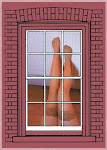Un hombre camina encima de un muro.Esas líneas del poema escrito por el propio Sharon Fridman quizas explican Al menos dos caras. Literalmente, un hombre caminaba encima de un muro.
A un lado el espacio exterior,
al otro el silencio del ser...
... Un muro llega para sujetar el ser,Al menos dos caras fue como un sueño donde todo es posible, no existe la ley de la gravedad, se cae pero no se cae del todo. Y para mí era como estar dentro de este sueño y no quería despertarme. Las escenas, gracias a "la casa-habitación-sobre ruedas", iban cambiando como en los sueños, a veces en camara lenta y otras muy rápidamente.
Caminó encima del silencio,
permitiendo el inicio de la caida...
Dos caras es íntima, intimista. Son pequeñas autobiografías. Es el amor y la confianza mutua. Es una mano amiga que vela por ti mientras sueñas. Y cito a Fridman otra vez
...una mano firme se abre
Llegó allí para sujetar la caída...
NOTAS: 1. Hay cosas que las madres no debemos saber sobre nuestros hijos, y los equilibrios que hace Arthur Bernard Bazin sobre el montaje tan frágil de la "casa-habitacion-rodante" serían una de ellas.
2. Fue casualidad que el dramaturgo Antonio Ramirez-Stabivo se pareciera físicamente a Fridman? Estéticamente, los dos morenos y el rubio Bazin ayudaron a crear la atmósfera de irrealidad, de imagenes en un espejo, en un ser y un alter-ser. (No digo ego y alter-ego a propósito)
3. Estoy esperando con ganas otra producción de Fridman.
Fotos AQUÍ (son fotos de Eter)
A man walks on a wallthese few lines from the poem by Sharon Fridman might explain Al menos dos caras (At least two faces). A man literally walked on a wall.
On one side outer space
on the other the silence of being...
...A wall is there to support the manAl menos dos caras is a dream and like in dreaming everything is possible, gravity doesn´t exist, one falls but never hits bottom. For me it was like being in that dream and I didn´t want to wake-up. The scenes, thanks to the moving room stage-set changed, dream- like, sometimes in slow motion, others in real-time.
Walking on the silence
allowing the start of the fall...
Dos caras is intimate, composed of small cameos. It is autobiographical. It is about love and mutual trust and helping hands that protect you while you sleep (or fall.) And to quote Fridman again
...a steady hand opens and is there to vouchsafe the fall...
Foot notes 1: There are things that mothers shouldn´t know about their children and seeing the balancing tricks that Arthur Bernard Bazin does on top of the fragile moveable wall is one of them
2: Was it a coincidence that the dramatist Antonio Ramirez -Stabivo is physically very similar to Fridaman. The two dark haired men and the blond Bazin helped create an unreal atmosphere, mirror images, beings and alter-beings. (I do not mean ego-alter-ego)
3: I can´t wait for Fridman´s next production!
Pics HERE (Thank you, Eter!)



